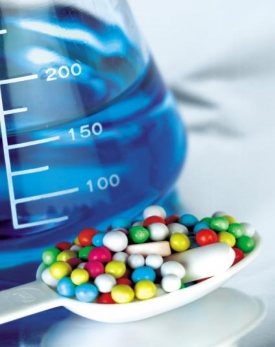Aerospace
Automotive
Chemical
Consumer Goods
Energy
Environmental Technology
Financial Services
Logistics & Transportation
Machinery & Equipment
Media & Entertainment
Medical Technology
Pharmaceuticals & Biotech
Professional Services
Retail Trade
Semiconductors
Software & Information Technology Services
Textiles
Travel, Tourism & Hospitality
Events

The United States is the world’s largest market for pharmaceuticals and the world leader in biopharmaceutical research. According to the Pharmaceutical Research and Manufacturers Association (PhRMA), U.S. firms conduct the majority of the world’s research and development in pharmaceuticals and hold the intellectual property rights on most new medicines. The biopharmaceutical pipeline also has over 5,000 new medicines currently in development around the world with approximately 3,400 compounds currently being studied in the United States - more than in any other region around the world.
More than 810,000 people work in the biopharmaceutical industry in the United States as of 2012, and the industry supports a total of nearly 3.4 million jobs across the U.S. economy, including jobs directly in biopharmaceutical companies, jobs with vendor companies in the broad biopharmaceutical supply chain, and jobs created by the economic activity of the biopharmaceutical industry workforce. The biopharmaceutical sector is one of the most research and development (R&D)-intensive in the United States, with companies investing more than 10 times the amount of R&D per employee than all manufacturing industries overall.
The markets for biologics, over-the-counter (OTC) medicines, and generics show the most potential for growth and have become increasingly competitive. Biologics account for a quarter of all new drugs in clinical trials or awaiting U.S. Food and Drug Administration approval. OTC market growth will be driven by a growing aging population and consumer trend to self-medication, and the conversion of drugs from prescription to non-prescription or OTC status.
The U.S. market is the world’s largest free-pricing market for pharmaceuticals and has a favorable patent and regulatory environment. Product success is largely based on competition in product quality, safety and efficacy and price. U.S. government support of biomedical research, along with its unparalleled scientific and research base and innovative biotechnology sector, make the U.S. market the preferred home for growth in the pharmaceutical industry.
Industry Subsectors
The innovative pharmaceutical industry in the United States produces chemically-derived drugs developed as a result of extensive R&D and clinical trials in both humans and animals. The innovator relies on patents and other forms of intellectual property rights to justify the investment required to bring a product to market (the U.S. patent term is 20 years). The pharmaceutical industry is heavily dependent on the development of new molecules to replace the revenue stream of older drugs that have come to the expiration of their patent terms. Several large multinationals produce the majority of innovative pharmaceuticals globally, but they have come to rely more heavily on research performed by industry partners, including smaller, innovative manufacturers. Pricing of innovative pharmaceuticals is designed to recapture R&D expenditures.
The biopharmaceutical industry produces medical drugs derived from life forms (biologics). These include proteins (including antibodies), and nucleic acids (DNA, RNA or antisense oligonucleotides) used for therapeutic or in vivo diagnostic purposes, and are produced by means other than direct extraction from a native (non-engineered) biological source. A potentially controversial method of producing biopharmaceuticals involves transgenic organisms, particularly plants and animals that have been genetically modified to produce drugs. The biopharmaceutical industry relies heavily on research performed by small companies and academic institutions that is either acquired by large companies that can bring the products to commercialization, or independently financed.

Biologics (both biologics and biosimilars) include a wide range of products such as vaccines, therapeutic proteins, blood and blood components, tissues, etc. Major pharmaceutical companies continue to diversify into biologics through acquisitions of biotechnology companies, in-licensing of products, and R&D alliances. Some biotech firms have chosen to license their products through joint ventures with multinational pharmaceutical partners, while reserving rights to the domestic market. The term biosimilar refers to products that have similar properties to existing biologic products.
The generic pharmaceutical industry produces copies of innovative pharmaceuticals that contain the same active ingredient, are identical in strength, dosage form, and route of administration. In the United States, upon patent expiration or a successful challenge of relevant patents, a manufacturer can produce a generic drug as long as the drug meets USFDA regulatory requirements and USFDA provides clearance to the applicant. The prices of generic drugs are typically lower than the prices of innovative drugs. Many generic drug manufacturers are also producers of biosimilars. Generic drug manufacturing is heavily reliant on efficient production methods and distribution chains, and based on volume rather than price to make profits. Regulatory systems governing patent expiration are important to generic producers, as are approval systems for biologics and biosimilars.
Industry Associations:
Consumer Healthcare Products Association (CHPA)
Generic Pharmaceutical Association (GPhA)
International Pharmaceutical Expedient Council
Pharmaceutical Research and Manufacturers of America (PhRMA)
Synthetic Organic Chemical Manufacturers Association (SOCMA)
Biotech Industry Association (BIO)
Industry Publications:
“The Pink Sheet”
FDA News
Pharmacy Times
Drug Topics
U.S. Pharmacist
BioTechniques
Laboratory Equipment
LabMedicine
Genetic Engineering & Biotechnolog News
The Scientist
Bioscience Technology
P&T Journal
Chain Drug Review
Community Pharmacist
Eye for Pharma
Formulary
Pharmaceutical Technology
The Lancet
Drug Discovery & Development
Pharmaceutical Processing
American Pharmaceutical Review
BioPharm International
Drug Discovery News
BioProcess International
Drug Benefit Trends
Pharmaceutical Manufacturing
Contract Pharma
Applied Clinical Trials
Pharmaceutical Executive
PharmaVOICE
Pharmaceutical Formulation & Quality
Pharmaceutical Outsourcing
R & D Directions
Pharmaceutical Commerce
Tablets & Capsules